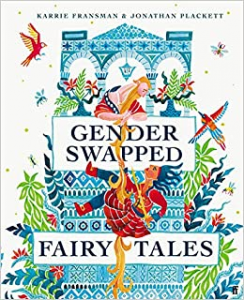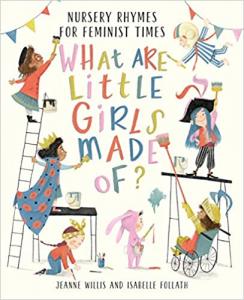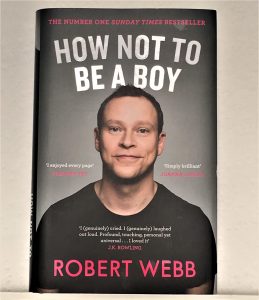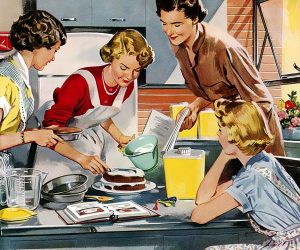Maxime Perrott
Reading books together as a family is one of the most beneficial ways to reconnect with each other after a busy day. But also, to share stories that reflect the beliefs and values we want our children to be surrounded by.
Research has shown that children can be seen to ‘do gender’ at a young age. Where in a range of social contexts children establish and enforce gender boundaries in ways that reflect their ideas of gender difference (Messner 2000). Therefore, it is up to us to show them that a child’s gender should not, and need not, constrain them. So, all children are free to become and be whatever they want in life.
Here I have collected 5 of my favourite books that tackle the sometimes-complex concept of gender. Along with a summary of recent parent reviews from Amazon. These are books for all the family to enjoy. They are unified in the message that every child can really be anything, and express themselves, in any way they want.
- Gender Swapped Fairy Tales.

This is a beautiful and thoughtful book comprised of classic tales many
will be familiar with. With the gender identifiers switched. None of the original story lines have been tampered with and the moral endings remain the same, just the characters’ genders have been swapped.
The original illustrations are beautifully designed full of colour. This book is sure to captivate the whole family and can be read together for years to come.
What parents say:
From the 10 most recent reviews, 7 are positive. These are centred around how the small change of gender seems to really impact the story telling and how it has brought to parents’ attention that some of the most loved and well-known fairy tales have shaped our perceptions of gender. The less positive reviews commented on the awkward wording of the stories and how they are at times, inappropriate for very young children.
- Julian is a Mermaid.
 I found this to be a charming picture book. It tells the story of young Julian who, after seeing three women dressed up on the subway one day, creates himself a fabulous mermaid costume.
I found this to be a charming picture book. It tells the story of young Julian who, after seeing three women dressed up on the subway one day, creates himself a fabulous mermaid costume.
A story full of heart, this is a book all about individuality and at its core a champion for self-confidence and love. And if you and your family enjoy this book there is also a sequel Julian at the Wedding.
What parents say:
This book has 5 stars and over 2,500 reviews on Amazon, so definitely a firm favourite with many parents. It is described as a ‘joy’. Reviewers commented on how it is beautifully written and illustrated, pointing out how Julian’s Nana is written as being calm and accepting.
- What are little girls made of?

This is a clever and funny book that comprises of revamped traditional nursery rhymes with a feminist twist. Full of witty illustrations these new and improved nursery rhymes champion the idea that girls can do whatever and be whatever they want, and most importantly are the heroes of any story!
This is a fun and easy to read book for the family to share together and especially for those with children aged between 3 and 5.
What parents say:
The 190 online reviews are largely positive and emphasis the empowering message of this book. It is routinely described as fun, refreshing and a must read for any family raising girls in this ‘new and modern world of gender equality.’
However, we still have a long road ahead for achieving true gender equality. Women are still routinely missing from top jobs in many industries, and although progress has been made in some areas, it remains too slow (Kaur 2020). And a recent survey carried out for the UN found that 97% of women have been sexually harassed in the UK (Advanced Pro Bono 2021).
Figures like these, show why it is so important to normalise the idea of gender equality from a young age and really encourage our young girls and boys to become whatever they want to be. But also, to be true to themselves, and not pre-defined gender norms.
If these are topics that interest you, and you would like to learn more, please see the ‘Further Reading’ section at the end of this article
- Little Feminist Picture Book (Little People Big Dreams collection)
 A great book honouring 25 amazing women throughout history. Featuring politicians, athletes, scientists, artists and more, I found this book inspiring and really champions the idea that any young girl can become whatever they want to be.
A great book honouring 25 amazing women throughout history. Featuring politicians, athletes, scientists, artists and more, I found this book inspiring and really champions the idea that any young girl can become whatever they want to be.
As part of the Little People Big Dreams book collection there are plenty more inspiring reads to collect. Although I recommend this as the starting book for the collection. Especially for families with pre-school aged children, as it comes in hardcover and the short biographies are easy and enjoyable to read as a family.
What parents say:
Unsurprisingly, given the popularity of this collection, comments are overwhelmingly positive about this book. With 9 out of ten of the most recent reviews scoring it 5 stars. Reviewers comment on how well received the book is by their children and the inspiring women that are included.
- Good night stories for rebel girls/Good night stories for boys who dare to be different.
Although technically two books, I just could not mention one without the other! These are award winning, bestseller books for a reason. I found these books full of inspiring women and men, who despite of constricting gender norms and difficult backgrounds have gone on to become amazing people and do amazing things.
I think these are wonderful books to empower young boys and girls. And no doubt they will start many meaningful conversations and be enjoyed by all the family.
What parents say:
These books have received 5 and 4.5 stars on Amazon, respectively. And with over 8,000 combined ratings, parents are unanimously positive about these books. Comments note the inspirational people included and the way their children enjoyed the books. Both books have been described as must-read books and really showcase the many different types of girls and boys who have gone done simply amazing things in life.


References:
Advance Pro Bono. 2021. Prevalence and reporting of sexual harassment in UK public spaces: A report by the APPG for UN Women. London: APPG for UN Women.
Kaur, S. 2020. Sex and Power 2020. London: Fawcett Society.
Messner, M. A. 2000. Barbie Girls Versus Sea Monsters: Children Constructing Gender. Gender and Society 14(6), pp. 765 – 784.
Further Reading:
Gender Equality in the Workplace:
Article written by the guardian, titled ‘UK still “generations away” from equality in top jobs, study shows.’ This is available online:
UK still ‘generations away’ from equality in top jobs, study shows | Gender | The Guardian
Journal article discussing some of the reasons for inequality in the workplace:
Reskin. B. F. 1987. Bringing the men back in: Sex differentiation and the Devaluation of Women’s work. Gender and Society 2(1), pp. 58-81.
An ESRC funded report by the Institute of Fiscal Studies detailing the nature of the gender wage gap in the UK:
Dias, M. C. et al. 2016. The Gender Pay Gap. London: The Institute for Fiscal Studies.
Sexual Harassment of Women:
Article written by the Guardian: ‘Almost all young women in the UK have been sexually harassed, survey finds’ This is available online:
Journal article reviewing literature on workplace sexual harassment:
McDonald, P. 2012. Workplace Sexual Harassment 30 years on: A Review of the Literature. International Journal of Management Reviews 14, pp. 1 – 17.

 For example, in the Channel 4 series: The Secret Life of Five Year Olds, in which some of the boys demonstrate a historically held view by boys that they belong to a ‘club’ exclusive of girls and that the girls can only join in if they ‘cook’ for them. This shows enforc
For example, in the Channel 4 series: The Secret Life of Five Year Olds, in which some of the boys demonstrate a historically held view by boys that they belong to a ‘club’ exclusive of girls and that the girls can only join in if they ‘cook’ for them. This shows enforc Lack of self-understanding leads to a fear of what others perceive us as and an introversion of our views and understanding of others. Encouraging children to experiment with different groups of toys and clothing regardless of gender allows the child to develop understanding and appreciation of differing views and cultures. Although it may be said that it is the job of the parents to decide what their children play with, school is the only place in which we can ensure that every child is given the appropriate tools to navigate our social world. Making this sort of experimentation a compulsory part of the curriculum ensures through policy that self-knowledge is fostered and embraced.
Lack of self-understanding leads to a fear of what others perceive us as and an introversion of our views and understanding of others. Encouraging children to experiment with different groups of toys and clothing regardless of gender allows the child to develop understanding and appreciation of differing views and cultures. Although it may be said that it is the job of the parents to decide what their children play with, school is the only place in which we can ensure that every child is given the appropriate tools to navigate our social world. Making this sort of experimentation a compulsory part of the curriculum ensures through policy that self-knowledge is fostered and embraced. The danger of society requiring men and consequently boys to prove themselves as strongly masculine is that it steers them towards restricted options. To excel intellectually or to find another physical way to succeed in expressing this ‘masculinity’. This puts restrictive pressure on boys and creates friction between and within the genders. It creates segregation between those who express their masculinity intellectually and those who express their masculinity in a more physical way. This differentiation leads to exclusion of ‘gentle’ academic boys and girls, and a lack of academic confidence and support of the boys who express this physical masculinity.
The danger of society requiring men and consequently boys to prove themselves as strongly masculine is that it steers them towards restricted options. To excel intellectually or to find another physical way to succeed in expressing this ‘masculinity’. This puts restrictive pressure on boys and creates friction between and within the genders. It creates segregation between those who express their masculinity intellectually and those who express their masculinity in a more physical way. This differentiation leads to exclusion of ‘gentle’ academic boys and girls, and a lack of academic confidence and support of the boys who express this physical masculinity.

